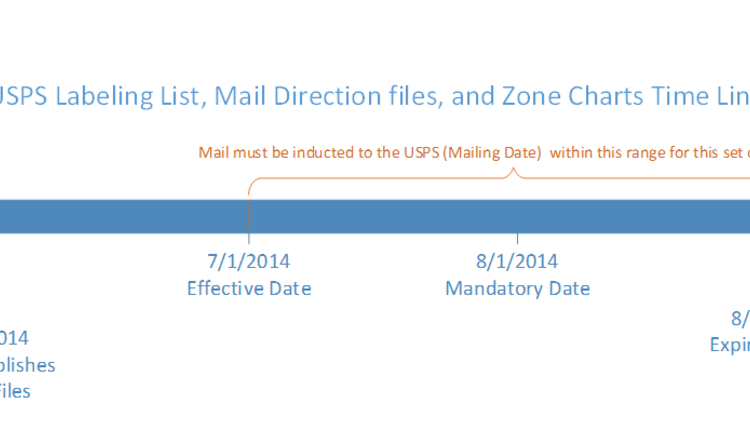There continues to be a lot of "belt-tightening" lately. At homes, businesses, and soon the United States Postal Service will also begin tightening its belt in a new area - compressing its processing network. Beginning in as early as March 2012, the USPS will begin a significant and what is surely to be tangibly felt reduction in processing facilities. The list of processing facilities that are being considered is posted on the USPS website and contains over 250 facilities across the country. That is more than half the current network today.
The reason for this compression is twofold. First, the current delivery network was built to process overnight delivery of First-Class Mail. Standard Mail is now the largest mail class by volume, with First-Class Mail declining 24% over the past four years. The second reason is delivery cost. According to the USPS at a recent MTAC (Mailers Technical Advisory Committee) meeting, it costs the USPS $10 million per day to support a processing network that was designed for a different time and different mail use than today. By compressing the network, the USPS hopes to further reduce their operation spending to match the reduced volume and revenue.
Compressing the delivery network, effectively in half, is no easy task. The USPS needs buy-in from numerous stakeholders, not the least of which is their unions and their customers. This network compression means significant changes to service performance and the USPS has already notified both the Postal Regulatory Commission, their unions, and the mailing industry (via MTAC) of the proposed compression. However, there is still another important stakeholder that needs to be considered in this and that is the software development community.
With $10 million at stake per day, the USPS has already stated they are anxious to get moving as quickly as possible to compress the network. During the August MTAC meetings, it was even suggested that the entire network compression be done by December 2012. Other recent discussions with USPS operations seem to imply a phased approach over the next two years. Regardless of the final date, everyone at MTAC appeared aligned to the idea that an initiative of this magnitude needs to be done collaboratively.
Mail preparation by PAVE (Presort Accuracy Validation and Evaluation) certified software, as outlined in the Domestic Mail Manual is entirely dependent upon and tied to current Labeling Lists. These Labeling Lists provide the active, originating ZIP Code to destination processing facilities for labeling and preparation purposes. For example, L005 is the Labeling List that outlines the 5-digit scheme sortation for pallets and sacks of Periodicals, Standard Mail, and Package Services flats and irregular parcels destined for multiple 5-digit ZIP Codes served by a single delivery unit.
In all, there are 18 Labeling Lists that are used by PAVE certified software for proper mail preparation and induction. Any change to the processing facility network means a change to these Labeling Lists. And with over 200 facilities being considered for compression, that could mean significant software and underlying Labeling List changes in order to reflect a dynamic shift in mail preparation and induction rules.
Earlier this year, the USPS and the Mailing Software Development Group (a working group within IDEAlliance) initially agreed to a 2012 release schedule for Labeling Lists and other critical postal preparation tables. This release schedule is publicly available on RIBBS (https://ribbs.usps.gov/). In the schedule, it was agreed that Labeling Lists would be released six times per year. However, if the USPS intends to move forward with the processing network compression, that release schedule itself may need to also be compressed and thus software vendors and their users could be squeezed into a state of rapid-fire software updates.
The MSDG members are continuing to work with the USPS in seeking an implementation plan that can take into consideration minimally disruptive software changes in conjunction with a sufficient window of time to implement Labeling List changes. Recognizing that a mailing is presorted in data days or weeks before the actual induction of a physical product, it is important to have a sufficient transition window established between where mail is inducted today and where it will be inducted later in 2012 and beyond.
In the meantime, software users need to stay informed about these facility changes. Users should work with their current software provider to understand the planned release schedules. They should also check with their local acceptance office (either Detached Mail Unit or Business Mail Entry Unit) to see if what changes are being considered for local entry of mail.
The reason for this compression is twofold. First, the current delivery network was built to process overnight delivery of First-Class Mail. Standard Mail is now the largest mail class by volume, with First-Class Mail declining 24% over the past four years. The second reason is delivery cost. According to the USPS at a recent MTAC (Mailers Technical Advisory Committee) meeting, it costs the USPS $10 million per day to support a processing network that was designed for a different time and different mail use than today. By compressing the network, the USPS hopes to further reduce their operation spending to match the reduced volume and revenue.
Compressing the delivery network, effectively in half, is no easy task. The USPS needs buy-in from numerous stakeholders, not the least of which is their unions and their customers. This network compression means significant changes to service performance and the USPS has already notified both the Postal Regulatory Commission, their unions, and the mailing industry (via MTAC) of the proposed compression. However, there is still another important stakeholder that needs to be considered in this and that is the software development community.
With $10 million at stake per day, the USPS has already stated they are anxious to get moving as quickly as possible to compress the network. During the August MTAC meetings, it was even suggested that the entire network compression be done by December 2012. Other recent discussions with USPS operations seem to imply a phased approach over the next two years. Regardless of the final date, everyone at MTAC appeared aligned to the idea that an initiative of this magnitude needs to be done collaboratively.
Mail preparation by PAVE (Presort Accuracy Validation and Evaluation) certified software, as outlined in the Domestic Mail Manual is entirely dependent upon and tied to current Labeling Lists. These Labeling Lists provide the active, originating ZIP Code to destination processing facilities for labeling and preparation purposes. For example, L005 is the Labeling List that outlines the 5-digit scheme sortation for pallets and sacks of Periodicals, Standard Mail, and Package Services flats and irregular parcels destined for multiple 5-digit ZIP Codes served by a single delivery unit.
In all, there are 18 Labeling Lists that are used by PAVE certified software for proper mail preparation and induction. Any change to the processing facility network means a change to these Labeling Lists. And with over 200 facilities being considered for compression, that could mean significant software and underlying Labeling List changes in order to reflect a dynamic shift in mail preparation and induction rules.
Earlier this year, the USPS and the Mailing Software Development Group (a working group within IDEAlliance) initially agreed to a 2012 release schedule for Labeling Lists and other critical postal preparation tables. This release schedule is publicly available on RIBBS (https://ribbs.usps.gov/). In the schedule, it was agreed that Labeling Lists would be released six times per year. However, if the USPS intends to move forward with the processing network compression, that release schedule itself may need to also be compressed and thus software vendors and their users could be squeezed into a state of rapid-fire software updates.
The MSDG members are continuing to work with the USPS in seeking an implementation plan that can take into consideration minimally disruptive software changes in conjunction with a sufficient window of time to implement Labeling List changes. Recognizing that a mailing is presorted in data days or weeks before the actual induction of a physical product, it is important to have a sufficient transition window established between where mail is inducted today and where it will be inducted later in 2012 and beyond.
In the meantime, software users need to stay informed about these facility changes. Users should work with their current software provider to understand the planned release schedules. They should also check with their local acceptance office (either Detached Mail Unit or Business Mail Entry Unit) to see if what changes are being considered for local entry of mail.









